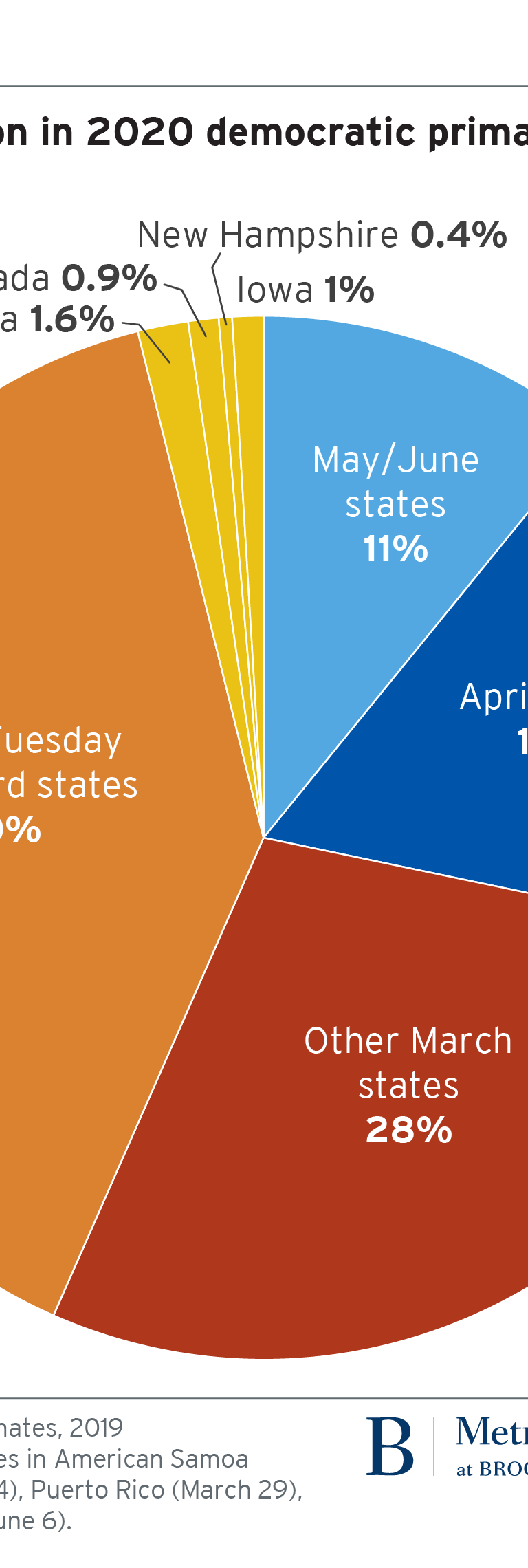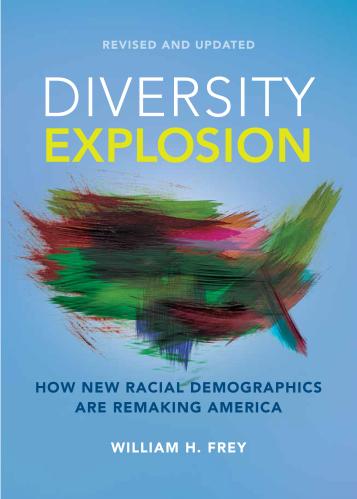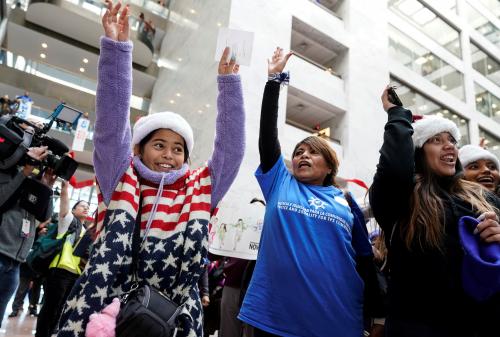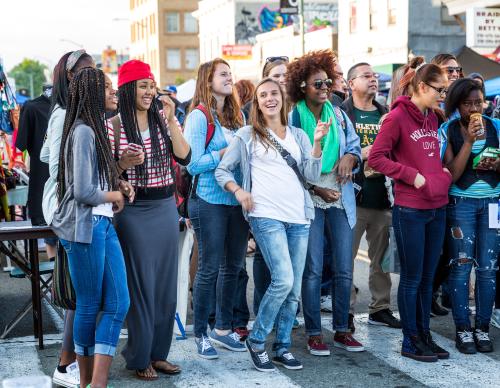After over a year of polling, debates, and punditry on who will become the Democratic Party’s 2020 standard-bearer, actual voting is about begin on February 3. A long train of primaries and caucuses follows through June 6, but the results in the first four states to cast ballots—Iowa, New Hampshire, Nevada, and South Carolina, which are home to less than 4% of the country’s population—will exert an outsized influence on which of the 12 remaining Democratic candidates stay in the race.
Just how demographically skewed are these states compared to the rest of the country? And what will be the impact of primaries in the later, more nationally representative states as they enter the picture?


It is well known that the first two states to vote—Iowa and New Hampshire—differ sharply from the nation on their racial-ethnic attributes. With a white population share of 85% and 90%, respectively (compared to 60.4% for the nation as a whole), they are the sixth and fourth “whitest” states. They also have somewhat older age structures, decidedly less urbanized populations, and a much higher representation of white adults without college educations (“noncollege whites”) than the rest of the nation.
These attributes, interestingly, are more associated with Republican voters than Democratic ones. So Iowa and New Hampshire voters in their Democratic caucus/primary are more likely to be whiter, older, and comprised of more noncollege whites than primary voters in other states, as was the case in the 2016 presidential primaries.

Many observers argue that the other two February contests, in Nevada (February 22) and South Carolina (February 29), “make up” for the lack of diversity in the first two states. Nevada is one of the nation’s fastest-growing states, and racial minorities comprise a large share of its growth. It houses a substantial Latino or Hispanic population and sizeable Black and Asian American populations, and it is one of five states where whites are a minority (at 48.7%). In this respect, it is much more diverse than the nation as a whole. Additionally, it is younger, more urbanized, and has fewer noncollege whites. Since these are Democratic-leaning attributes, they should be overrepresented among voters in Nevada’s Democratic caucus.
South Carolina is also more diverse than Iowa and New Hampshire, though still whiter (at 64%) than the country as a whole. While Nevada possesses a sizeable Latino or Hispanic population, South Carolina houses a substantial Black population (26.6% of its residents, compared to 12.5% nationally), and Black voters should comprise a healthy share of Democratic primary voters, as was the case in 2016. The state provides a glimpse of how candidates would fare in the rest of the South.
Although the diversity of Nevada and South Carolina counter the extreme lack of diversity in Iowa and New Hampshire, the combined population of these four states is still whiter, older, and far less urban than the nation as a whole. And aside from Las Vegas, there is a relative absence of large urban populations or white, working class residents from the Rust Belt—two mainstays of the Democratic Party’s national electorate.
Perhaps this year, with several top candidates remaining in the mix, there may still be a healthy competition for voters when “Super Tuesday” primaries arrive on March 3. Here, 14 states—home to two-fifths of the nation’s population—will provide a much broader spectrum of demographic attributes (See downloadable table). As a group, Super Tuesday voters (which include those from the nation’s two largest states, California and Texas) are more racially diverse than the nation and somewhat younger.

Although Super Tuesday states span every region, seven of them—comprising more than half of the combined voting population that day—are in the South. In addition to Texas, they include North Carolina, Virginia, and Tennessee, as well as Alabama, Arkansas, and Oklahoma. As a group, these states should show which candidates will do best among Black and southern white voters. California, which moved up its primary from June after the 2016 election, will be a bellwether for examining which candidates will do well in an urbanized, diverse, and more progressive state. And the results in Massachusetts, Maine, and Vermont will provide a sense of which candidates can stand out in New England.
If a consensus candidate is still not chosen by Super Tuesday, the rest of March’s primary calendar—comprised of 11 states and another 28% of the population—might bring some closure. Together, this group of states comes closer to the nation in their demographic make-up. It includes several key Midwest industrial states: Michigan and Missouri on March 10 and Illinois and Ohio on March 17. Also voting will be a smattering of western states, including Idaho, Washington, and Arizona, as well as two pivotal southern states, Florida and Georgia.
If the race remains undecided at the end of March, there are key contests in the last two-plus months of the primary season. In April, 11 states, constituting 17% of the population, could be consequential. Louisiana and Wisconsin hold primaries in the first week of the month, and on April 28, primaries are held in a blockbuster group of Atlantic coastal and northeastern states including New York, Pennsylvania, Maryland, Connecticut, Rhode Island, and Delaware.
It’s difficult to say now whether the 10 states (as well as the District of Columbia) holding primaries in May and June will play a role in selecting the party’s nominee. But if they do, these states will give greater sway to voters who are, on the whole, whiter, older, and less urbanized than the rest of the nation. These include Kansas, Indiana, Nebraska, West Virginia, Kentucky, Oregon, Montana, and South Dakota. Among the May/June primary states, only New Jersey, New Mexico and Washington, D.C. are considered racially diverse.
The map of Democratic primaries and caucuses provides a winding road across states with very different demographic profiles. Quite clearly, the first two states (Iowa and New Hampshire) come close to being the least representative of America. Even Nevada and South Carolina don’t totally make up for the formers’ extreme demographic profiles.
With the large group of candidates vying for the 2020 Democratic nomination, it is possible that the winner will not be chosen until April, May, or perhaps June. But even so, the first four February states—hardly representative of the nation—will have a disproportionate influence on the money, press attention, and polling that will come to determine the outcome.








Commentary
Just how demographically skewed are the early Democratic primary states?
January 31, 2020